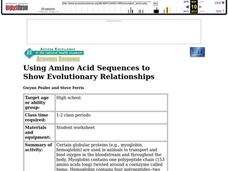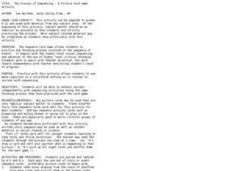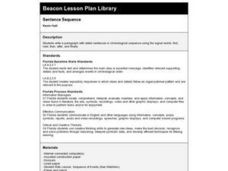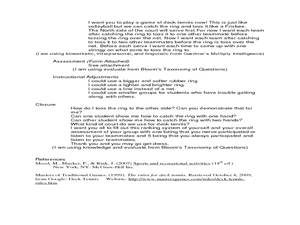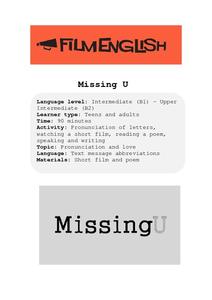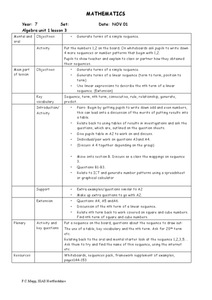Curated OER
The Watson-Crick Model of DNA Structure
Junior geneticists construct models of DNA to discover sequencing and pairing of nucleotides. They use the models to simulate protein synthesis and then translate the codes into physical traits. Finally, they use the traits to create a...
Curated OER
Sequencing
Second graders retell a story focusing on sequence. in this sequence activity, 2nd graders read the story Carry Go Bring Come by Vyanne Samuels. They retell parts of the story and put them in the correct order.
Curated OER
Using Amino Acid Sequences to Show Evolutionary Relationships
Compare protein fragments, count amino acids, and use the information to explore common ancestry. The resource mentions a student worksheet, however, a separate printable worksheet is not provided. The exercises are written into the...
Pearson
Rumpelstiltskin
Classic fairy tales are great! They have memorable characters, present interesting story lines, and lend themselves to art projects. Grab a copy of "Rumpelstiltskin" and get ready to participate in several early literacy activities. The...
Curated OER
Geometric Sequences and Series
Learn to calculate the nth term of a sequence defined by an algebraic expression. They examine geometric sequences and series, relate geometric sequences to their explicit forms, find the partial sums of a sequence in a table, and...
Curated OER
Geometric Sequences and Series
Learners find common ratios of geometric sequences on a spreadsheet. Using this data, they create scatter plots of the sequences to determine how each curve is related to the value of the common ratio. They will consider whether series...
Curated OER
The Process of Sequencing- A Picture Card Game Activity
Students put the events of a story in the correct order. In this sequencing lesson, students are paired up and labeled A or B. Students in each group receive a set of story or event sequence cards and they take turns drawing...
Curated OER
The Process of Sequencing - A Picture Card Game
Students play a picture card game where they have to sequence the pictures in the correct order. In this sequencing lesson plan, students can do this for any subject.
Curated OER
Sentence Sequence
Second graders write a paragraph with detail sentences in chronological sequence.
Curated OER
Guess That Sequence!
Pupils analyze number sense by participating in a pattern identification activity. In this number sequence lesson, students examine several groups of numbers and identify the sequence in the group before adding on to it. Pupils check...
Curated OER
Cut-off Genes
Investigate the relationships between different deep-sea organisms by DNA sequencing. A worksheet provides instructions for DNA sequencing and space to work. They simulate gel electrophoresis by cutting out paper "DNA strands."...
Curated OER
Range, Cluster, Gap and Outliers
There are a number of activities here where learners collect and record data, as well as, activities where the likelihood of an event happening is calculated given the experimental probability. Young statisticians organize information...
Curated OER
The Beginning, The Middle, & The End
Cut magazine pictures into three sections, having your youngsters piece the pictures back together. With this fun activity, they discover the importance of sequencing a story. Then they use a fun template (shaped like a burger) to write...
TryEngineering
Sorting Socks is Algorithm Complexity
Use hosiery to teach computer science. Scholars use socks to develop a set of algorithms. They find ways to find a particular sock from a set and ways to sort socks. Finally, they use their algorithms to consider time complexity.
Curated OER
Deck Tennis
Seventh graders study deck tennis. For this lesson that can be adapted to teach movement, passing and positioning in any sport, 7th graders toss and catch a rubber ring, students of varying abuilities will be able to participate in this...
Curated OER
Crater Creation
After looking at the back of a quarter featuring Oregon terrain, learners distinguish between fiction and non-fiction and identify the beginning, middle and end of a story. First, they listen to legends that describe the creation of...
Virginia Department of Education
Freshwater Food Chains
What's in the water? Encourage your class to further explore this question and learn about pond ecosystems, food chains, and food webs as they complete this hands-on activity. They view the environment from a new perspective...
Curated OER
Thrilling Information: Music and Reading
Here’s a cross-curricular program music activity that uses Peer Gynt to engage class members. Groups take one section of “In the Hall of the Mountain King,” choreograph their section of the tune to represent the story as they imagine it,...
Science 4 Inquiry
Genetics, Genetics, and More Genetics: Exploring Independent Assortment and Non-Mendelian Genetics
Two individuals share 99.9 percent of their genetic codes, yet diversity is observed everywhere. Young scientists learn about diversity through hands-on activities and an experiment. They apply the concepts of independent assortment and...
Film English
Missing U
Explore the relationship between U and I with a video and related activities. First, pupils have some fun with the alphabet and discuss text message language. Next they practice coming up with words that have the same sound a I and...
Virginia Department of Education
The Cell Cycle and Mitosis
What a packed lesson! Provide your class with the opportunity to learn about the cell cycle in several exciting ways. Biologists first learn about the theory behind mitosis, then proceed to view onion tips under the microscope and create...
Curated OER
Simple Sequence
Students identify the nth term in a sequence. For this algebra lesson, students generate sequences given the formula for each sequence. They find the formula given the sequence.
Curated OER
Sequence Of Events
Third graders are introduced to the concept of sequence of events. They work in groups to properly sequence The Three Little Pigs, then work individually to write their own stories about their individuality.
Curated OER
Transcription and Translation Lab Activity
Students investigate DNA strands. They study the sequence to determine if it is DNA or RNA and write the mRNA nucleotide sequence. After stringing the beads together to create the mRNA sequence they translate it into an amino acid...
Other popular searches
- Story Sequencing Activities
- Free Sequencing Activities
- Pizza Sequencing Activities
- Math Sequencing Activities
- Sequencing Activities 3rd
- Sequencing Activities Apples
- Money Sequencing Activities
- English Sequencing Activities
- Recipe Sequencing Activities
- Reading Sequencing Activities


